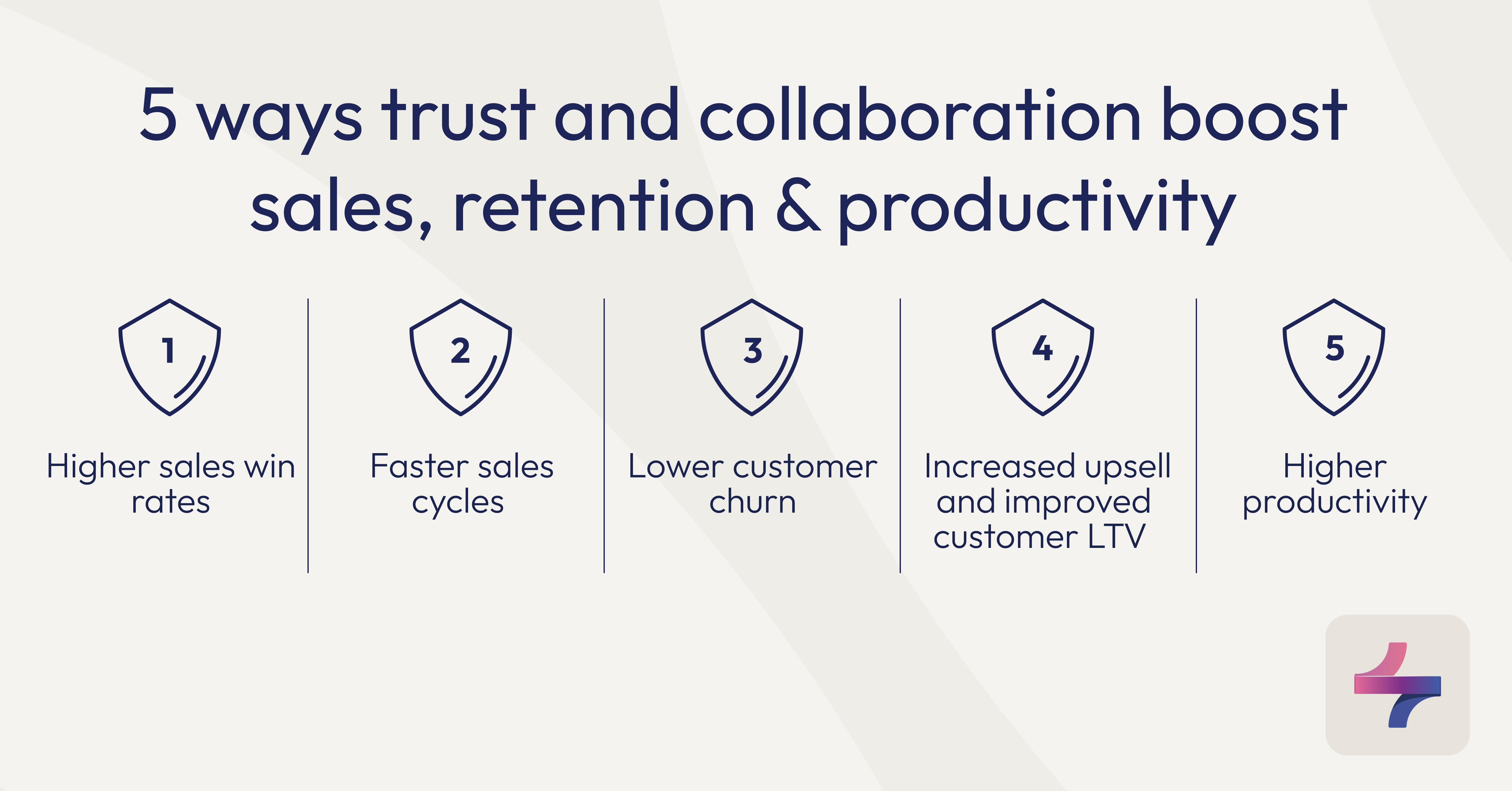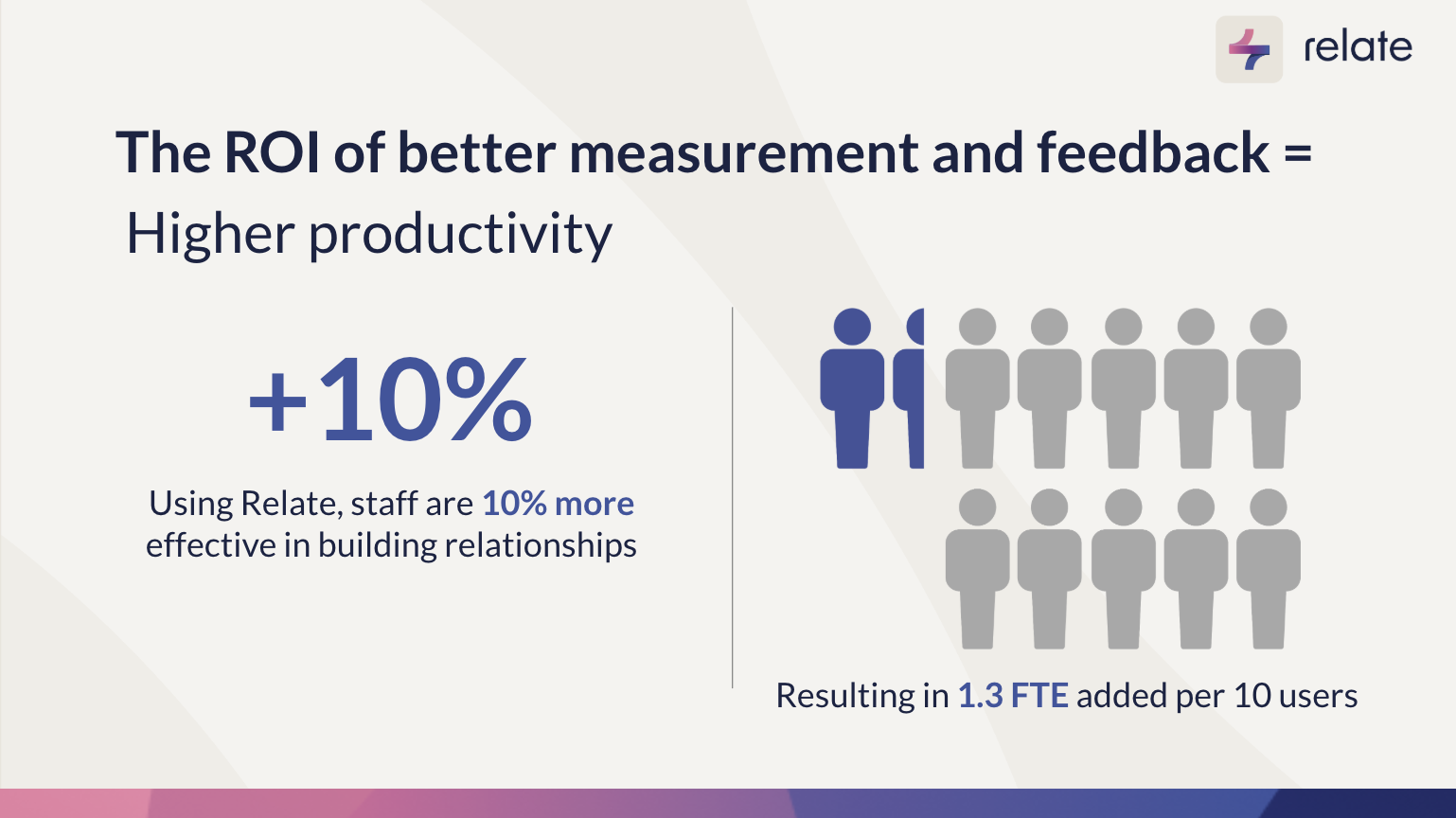
Discover the ROI of better meetings. Learn how trust and collaboration improve win rates, shorten sales cycles, reduce churn, and drive measurable business growth.
The ROI of better meetings: turning trust into profit
When meetings are run well, they do more than share updates. They build trust, align teams, and drive the kind of collaboration that directly impacts revenue. And when they’re run poorly, they erode trust, create hidden costs, and stall business growth.
So, the question becomes: what is the ROI of better meetings?
Our research shows that better meetings deliver both cost savings and top-line revenue growth. They reduce wasted time, strengthen internal alignment, improve customer trust, and lead to measurable financial outcomes. This isn’t just about saving a few hours a week. It’s about improving win rates, shortening sales cycles, increasing customer lifetime value, and boosting team engagement and productivity.
In this blog, we’ll break down the numbers, the frameworks behind them, and the practical steps leaders can take to turn trust into profit.
Why ROI from meetings is so often overlooked
When executives calculate ROI, they focus on revenue, costs, and retention. Meetings rarely make it into the equation, even though employees spend at least 20% of their week in meetings, according to research by Fellow.
This is a blind spot. Meetings are where deals are advanced, customers are retained, and employees decide whether they’re aligned or disengaged. Improving meeting quality creates a multiplier effect across the organization.
Think of meetings as the engine of business relationships (internal and external). If the engine misfires, everything slows down. If it runs effectively, everything accelerates.
The hard ROI of better meetings
Our analysis combined internal data with external research from McKinsey, Forrester, Bain, and Gallup. The findings are clear: stronger relationships built in meetings produce measurable ROI. Here are the 5 benefits of better meetings.
1. Higher sales win rates
Closing more of your opportunities is the most immediate lever for increasing revenue without additional headcount or marketing spend.
Impact: Our own analysis finds that a 10% improvement building trust with new customers adds enough revenue to expand a 3 salesperson team by 1 after the first year. Our analysis is supported by a Forrester’s TEI study, of an established sales productivity tool, that found an increased focus on stronger customer relationships yielded +10% in new customer win rates in year 1.
Why it matters: Trust built early in the sales cycle results in better sales engagement, Stronger customer retention and higher credibility.

2. Faster sales cycles
The pace at which your business closes deals directly affects revenue and cash flow. Longer sales cycles drain resources, prolong uncertainty, and reduce the number of deals a team can achieve in a given year.
Impact: McKinsey and CommonPaper data show that trust-driven sales approaches can shorten cycles by 20–46%.
Why it matters: When buyers trust a seller, decisions come faster and require fewer internal approvals. Shorter sales cycles provide sales teams more time to focus on expanding their trust driven sales approach to more prospects, creating a virtuous cycle.
3. Lower customer churn
Acquiring a customer is just the beginning, keeping them is where long-term profitability lies. Even a modest churn reduction can dramatically improve lifetime value (LTV). Every retained account compounds value through renewals, upsells, and referrals.
Impact: Our own analysis finds that a 10% improvement in building trust with existing customers reduces churn by 3-5% and retains enough revenue to add 1 more FTE to an account management team of 3 after year 1 of LTV and a second after year 4. This is supported by analysis from Reichheld and Sasser (HBR) and SaaS Capital who found that companies who invest in customer success enjoy a 15-40% reduction in churn.
Why it matters: Stronger relationships and consistent handoffs reduce customer attrition.
4. Increased upsell and improved customer LTV
The most valuable customers aren’t just the ones you win, they’re the ones who grow with you. Trusted relationships open the door to upsell opportunities, expansion into new product lines, and multi-year renewals. Over time, this deepens customer commitment and maximizes lifetime value.
Impact: Analysis from Forrester TEI and Reichheld & Sasser found a 10–15% revenue uplift and +25–100% increase in lifetime value from existing customers when relationship health is tracked.
Why it matters: Relationship strength directly predicts renewal and retention.
5. Higher productivity
Beyond speed and alignment, trust and psychological safety improve how much a team can produce with the same resources.
Impact: Industry research show that high-collaboration, high-trust teams produce 20–25% more output. Gallup goes further to estimate that improving employee engagement through stronger relationships is an opportunity to unlock $9.6 trillion in productivity improvement. From our analysis productivity improvements as a result of stronger internal relationships (ex-sales and account management) adds 1 more FTE for every team of 7.
Why it matters: By creating an environment where people feel heard and empowered, leaders unlock discretionary effort — the “extra mile” work that is rarely captured in traditional KPIs but directly impacts output and innovation.
Why trust is the multiplier
The common thread across every ROI category is trust.
Trust is what makes buyers choose your solution over a competitor’s. It’s what keeps employees engaged. It’s what allows decisions to move forward instead of getting stuck in analysis paralysis.
According to the 2020 Edelman Trust Barometer, 70% of consumers say trusting a brand is more important today than in the past—and 53% believe that trust in the company behind a brand is the second most important factor when purchasing (only behind price).
Trust isn’t soft. It’s the currency of business.
What leaders can do to improve meeting ROI
So, how can leaders turn every meeting into an ROI driver? Here are three practical steps:
1. Measure trust, don’t assume it
Just like pipeline and revenue, trust should be measured. Are you showing up as credible, reliable, and prepared? Are you creating space for others to contribute? Relate makes these signals visible, so leaders know how they’re being perceived in real time.
2. Reinforce clarity and alignment
Trusted Advisor Associates emphasize that how you open a meeting sets the tone for trust. Every meeting should be anchored, giving it structure and shared purpose right from the start. Anchoring demonstrates reliability, respects participants’ time, and creates alignment before the conversation even begins.
Here are three simple ways to anchor a meeting:
Recap where you’ve been – Begin with a quick summary of the last conversation you had or the context leading into today. This reinforces reliability.
Set today’s agenda – Clearly outline what you want to accomplish. This builds clarity, prevents drifts, and saves wasted hours that erodes productivity.
Preview what’s next – Share how today’s meeting connects to the next step. This shows foresight, keeps momentum moving, and directly improves decision velocity.
Tip: One of the fastest ways to be seen as trusted is to take the first step in trust. As Charles Green explains in Bring a Risky Gift, don’t wait for others to trust you, take a small risk yourself. For example, share an early perspective or hypothesis you know could be wrong. It signals vulnerability and invites collaboration, which strengthens the relationship and increases win rates.
Anchoring is an ROI driver. Leaders who consistently start meetings this way create clarity, alignment, and trust, which translates into faster deal cycles, more deals won, and stronger customer retention.
3. Coach behaviors that build trust
Small shifts compound over time. Pausing before responding to reduce filler words. Summarizing at the end to reinforce reliability. Checking in to show empathy. These behaviors make meetings more effective and make trust measurable.
And the more you actively try to incorporate those behaviors, the more they’re embedded into your everyday meeting practices.
Case in point: From cost savings to growth engine
At a mid-sized SaaS company we modeled, improving meeting effectiveness had both immediate and long-term impact:
Cost savings:
Better onboarding reduced ramp times by 20–30%.
Reduction in manager time spent on supervision and check-ins, freeing up 3–5 hours per week.
Increased revenue:
Stronger sales meetings shortened cycles and increased deals won
Increased lifetime customer value
The lesson: the ROI of better meetings is both defensive (cutting waste) and offensive (driving growth).
Key takeaway: meetings are a strategic lever
Meetings are often dismissed as overhead. But our analysis proves the opposite: they are one of the most powerful levers leaders have to improve business performance.
When meetings reinforce trust, credibility, and clarity, the returns are exponential:
Faster decisions
More deals won
Higher customer lifetime value
Stronger team execution
Leaders who ignore meeting quality leave money on the table. Leaders who invest in it unlock measurable ROI.
Ready to turn trust into profit?
For a deeper dive into the data and frameworks, download our full research:
Turning Trust into Profit: Measurable Payoffs of People-Centric Selling→
